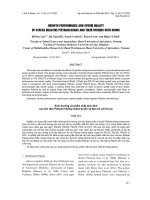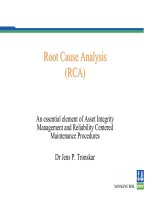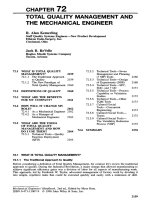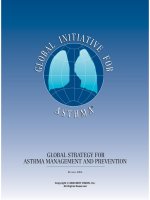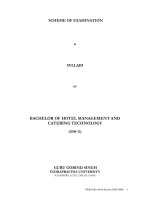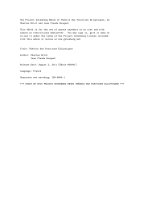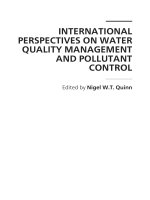stress at work management and prevention 2005
Bạn đang xem bản rút gọn của tài liệu. Xem và tải ngay bản đầy đủ của tài liệu tại đây (1.97 MB, 243 trang )
Stress at Work
Management and Prevention
This page intentionally left blank
Stress at Work
Management and Prevention
Jeremy Stranks
AMSTERDAM BOSTON HEIDELBERG LONDON NEW YORK OXFORD
PARIS SAN DIEGO SAN FRANCISCO SINGAPORE SYDNEY TOKYO
Elsevier Butterworth-Heinemann
Linacre House, Jordan Hill, Oxford OX2 8DP
30 Corporate Drive, Burlington, MA 01803
First published 2005
Copyright © 2005, Jeremy Stranks. All rights reserved
The right of Jeremy Stranks to be identified as the author of this work has
been asserted in accordance with the Copyright, Designs and Patents Act 1988
No part of this publication may be reproduced in any material form (including photocopying
or storing in any medium by electronic means and whether or not transiently or incidentally
to some other use of this publication) without the written permission of the copyright holder
except in accordance with the provisions of the Copyright, Designs and Patents Act 1988
or under the terms of a licence issued by the Copyright Licensing Agency Ltd, 90 Tottenham
Court Road, London, England W1T 4LP. Applications for the copyright holder’s written
permission to reproduce any part of this publication should be addressed to the publisher
Permissions may be sought directly from Elsevier’s Science & Technology Rights
Department in Oxford, UK: phone: (ϩ44) 1865 843830, fax: (ϩ44) 1865 853333,
e-mail: You may also complete your request on-line via
the Elsevier homepage (), by selecting ‘Customer Support’ and
then‘Obtaining Permissions’
British Library Cataloguing in Publication Data
A catalogue record for this book is available from the British Library
Library of Congress Cataloguing in Publication Data
A catalogue record for this book is available from the Library of Congress
ISBN 0 7506 6542 4
Typeset by Charon Tec Pvt. Ltd, Chennai, India
www.charontec.com
Printed and bound in Great Britain by Biddles Ltd, King’s Lynn, Norfolk
For information on all Elsevier Butterworth-Heinemann publications
visit our website at
Contents
Preface ix
1. Introduction to stress 1
1.1 What is stress? 1
1.2 Defining stress 2
1.3 Degradation of human performance 3
1.4 The evidence of stress 4
1.5 Stress as opposed to pressure 5
1.6 The cost of stress 5
1.7 The response of the courts to stress 6
1.8 The physiology of stress 7
1.9 A model of human performance and stress 11
1.10 The effects of stress 11
1.11 Occupational groups 13
1.12 Conclusion 14
Questions to ask yourself after reading this chapter 14
Key points – implications for employers 15
2. The causes of stress 16
2.1 Classification of the causes of stress at work 16
2.2 Factors contributing to stress at work 20
2.3 Categorizing the causes of stress 20
2.4 The main sources of work stress 21
2.5 Recognizing stress in the workplace 21
2.6 Stress within the organization 22
2.7 Organizational culture and change 24
2.8 Stress in the work group 27
2.9 Shift workers and other atypical workers 27
2.10 The home–work interface 31
2.11 Reducing stress at organizational level 31
2.12 Violence, bullying and harassment at work 32
2.13 Violence management 37
2.14 Conclusion 39
Questions to ask yourself after reading this chapter 40
Key points – implications for employers 40
3. Responses to stress 41
3.1 Symptoms of stress 41
3.2 Responses to prolonged stress 41
3.3 The stages of the stress response 42
3.4 Stress indicators 42
3.5 The effects of stress on job performance 44
3.6 Anxiety and depression 44
3.7 Role theory 48
3.8 Personality and stress 49
3.9 Submission, assertion and aggression 50
3.10 Crisis 52
3.11 Alcohol misuse 53
3.12 Drug misuse and addiction 57
3.13 Women at work 60
3.14 Conclusion 62
Questions to ask yourself after reading this chapter 62
Key points – implications for employers 63
4. The evaluation of stress 64
4.1 The measurement and evaluation of stress 64
4.2 Stress levels in occupations 65
4.3 Conclusion 66
Questions to ask yourself after reading this chapter 66
Key points – implications for employers 66
5. Coping with stress 67
5.1 Responding to stress 67
5.2 Personal coping strategies 69
5.3 Change management and stress 70
5.4 Organizational change 72
5.5 Personal change 73
5.6 Better time management 75
5.7 Dealing with personal crisis 75
5.8 Assertiveness training 77
5.9 Coping strategies 78
5.10 Relaxation therapy 78
5.11 Ideas for managing stress 79
5.12 Stress: what you can do 80
5.13 Conclusion 80
Questions to ask yourself after reading this chapter 81
Key points – implications for employers 81
Contentsvi
6. Stress in the workplace 82
6.1 Advice to employers 82
6.2 Strategies for reducing stress 83
6.3 Recognizing stress in the workplace 85
6.4 The need to consider human factors 86
6.5 Human behaviour and stress 87
6.6 Mentally and physically challenged employees 108
6.7 Workplace indicators of stress 109
6.8 Stress in groups 109
6.9 The sources of management stress: HSE guidance note HS(G)48 110
6.10 Stress and the potential for human error 111
6.11 Conclusion 111
Questions to ask yourself after reading this chapter 112
Key points – implications for employers 112
7. Managing stress at work 113
7.1 Employers’ responsibilities and duties in relation to stress 113
7.2 Duties of senior management: The human factors-related approach 115
7.3 Human factors and the need to manage stress 116
7.4 Developing a strategy 117
7.5 Strategies for managing stress 118
7.6 HSE management standards 119
7.7 Teamworking 122
7.8 Decision-making and stress 123
7.9 The work setting 123
7.10 Information, instruction and training 124
7.11 Communicating change 124
7.12 Creating a healthy workplace 125
7.13 Health promotion arrangements: Organizational interventions 126
7.14 Health surveillance arrangements 128
7.15 Personal stress questionnaire 128
7.16 Work-related stress risk assessment 130
7.17 Ergonomics and stress 135
7.18 Job design and organization 137
7.19 Stress management programmes 139
7.20 Occupational health schemes and services 140
7.21 Remedies for employers 140
7.22 FIET recommendations on limitations of work-related stress and
pressure affecting salaried employees 143
7.23 Termination of employment for work-related stress 144
7.24 Stress management action plans 145
7.25 A corporate fitness programme 149
7.26 EU principles of stress prevention 150
7.27 Conclusion 151
Questions to ask yourself after reading this chapter 151
Key points – implications for employers 152
Contents vii
Contentsviii
8. The civil implications 153
8.1 The landmark case 153
8.2 Principal areas of consideration 156
8.3 Court of Appeal guidelines: Employers’ obligations 161
8.4 Linking stress to the workplace 161
8.5 Recent cases 162
8.6 Practical propositions 167
8.7 Violence, harassment and bullying at work 169
8.8 Court of Appeal general guidelines 170
8.9 Establishing stress-induced injury 171
8.10 Liability for psychiatric illness 171
8.11 The remedies for employers 172
8.12 A corporate strategy 172
8.13 Conclusion 174
Questions to ask yourself after reading this chapter 174
Key points – implications for employers 174
9. The criminal implications 176
9.1 Health and Safety at Work etc. Act 1974 (HSWA) 176
9.2 What is health? 177
9.3 Management of Health and Safety at Work Regulations 1999
(MHSWR) 177
9.4 Management of Health and Safety at Work and Fire Precautions
(Workplace) (Amendment) Regulations 2003 179
9.5 HSE stress questionnaire 180
9.6 Stress and risk assessment 180
9.7 Health and Safety (Display Screen Equipment) Regulations 1992 184
9.8 The criminal implications of violence, bullying and harassment 190
9.9 Whistle blowing 198
9.10 Home working and stress 199
9.11 Disability Discrimination Act 1995 200
9.12 Disability arising from mental impairment 205
9.13 Employment tribunals and stress 206
9.14 HSE research reports 209
9.15 HSE management standards 210
9.16 Conclusion 210
Questions to ask yourself after reading this chapter 211
Key points – implications for employers 211
Appendix: Stress audit 213
Undertaking the audit 213
What is stress? 213
Action plan 217
10. Executive summary 219
Bibliography and further reading 222
Index 225
Preface
People at work worry about all sorts of things – increasing competition for jobs,
globalization, terrorism, ‘rationalization’ of the organization’s operations, looking
after ageing parents and relatives, the threat of redundancy, annual appraisals, new
technology, outsourcing of jobs to India and other Third World countries together with
increased demands by employers for higher productivity. Moreover, they may be put
under excessive pressure at certain times, for example, to meet sales targets, attend
meetings on time, learn and follow new procedures and fit in with changes in the organ-
ization’s culture. This can result in varying levels of stress. According to the Health
and Safety Executive, workplace stress is now the fastest growing cause of absence
from work.
What sort of employer are you? When your employees complain of stressful condi-
tions at work, do you reply with the old maxim ‘If you can’t stand the heat, get out of
the kitchen!’? The days when such a response from employers was common are over.
Employers now need to get to grips with a range of policies and procedures to deal
with stress at work.
What is important is that the poor standards of performance by many employees due
to the effects of stress at work represent a substantial financial loss to their organiza-
tions and the British economy. Moreover, recent cases in the civil courts, and the
greater attention now being paid to the subject of stress at work by the enforcement
agencies, means that employers need to consider stress in the workplace and the
measures they must take to prevent employees suffering stress arising from their work.
It is not uncommon for six figure sums to be awarded as damages in civil claims for
stress-induced injury.
This book has been written as a guide for managers. It should enable them to under-
stand the meaning of stress, the causes of stress, human responses to stress and aspects
of behaviour which are significant in this area. In particular, employers need to man-
age stress by incorporating stress protection for their employees into their manage-
ment systems.
The book incorporates a number of important features, including a stress audit, the
recent Court of Appeal general guidelines with respect to civil claims for stress-related
ill health, measures necessary with respect to bullying and harassment and procedures
for bringing stress management into operating procedures.
I would like to thank Dr Jacques Tamin of Interact Health Management for contribut-
ing the work-related stress (WRS) risk assessments.
Jeremy Stranks
August 2004
Prefacex
The recent civil court decision in which a senior social worker was awarded £175 000
compensation against his local authority employer for allowing him to work to the
point of breakdown raises the question as to whether claims for stress at work will be
the significant legal issue of the next decade.
Other claims have followed, including the claim involving a ticket collector who
received £375 000 in damages for post-traumatic stress disorder as a result of the
King’s Cross station fire.
Stress at work, and the potential for stress-induced ill health, has become a topical
subject with many people. Furthermore, most people can describe stressful events and
circumstances at work. Inefficient management, lack of decision-making by manage-
ment, excessive working hours, uncertainty as to future employment prospects and the
pressure of the job are some of the causes of stress described by employees.
1.1 What is stress?
‘Stress’ is a word which is rarely clearly understood and there is no single definition
of the term. It means different things to different people. Indeed, almost anything any-
one can think of, pleasant or unpleasant, has been described as a source of stress, such
as getting married, being made redundant, getting older, getting a job, too much or too
little work, solitary confinement or exposure to excessive noise.
Stress can be defined in many ways, thus:
● The common response to attack (Selye, 1936);
●
Any influence that disturbs the natural equilibrium of the living body;
●
Some taxation of the body’s resources in order to respond to some environmental
circumstance;
●
The common response to environmental change;
1
Introduction to stress
●
A psychological response which follows failure to cope with problems;
●
A feeling of sustained anxiety which, over a period of time, leads to disease;
●
The non-specific response of the body to any demands made upon it.
The CBI defines stress as that which arises when the pressures placed upon an
individual exceed the perceived capacity of that individual to cope.
According to the TUC, stress occurs where demands made on individuals do not
match the resources available or meet the individual’s needs and motivation. Stress
will arise if the workload is too large for the number of workers and time available.
Equally, a boring or repetitive task which does not use the potential skills and experi-
ence of some individuals will cause them stress.
The Health and Safety Executive (HSE) (1995) defined work stress as ‘pressure and
extreme demands placed on a person beyond his ability to cope’. In 1999, the Health
and Safety Commission (HSC) stated that ‘stress is the reaction that people have to
excessive pressures or other types of demand placed upon them’.
According to Cox (1993), ‘stress is now understood as a psychological state that
results from people’s perceptions of an imbalance between job demands and their abil-
ities to cope with those demands’.
A further definition is ‘work stress is a psychological state which can cause an
individual to behave dysfunctionally at work and results from people’s response to
an imbalance between job demands and their abilities to cope’.
Fundamentally, workplace stress arises when people try to cope with tasks, respon-
sibilities or other forms of pressure connected with their jobs, but encounter difficulty,
strain, anxiety and worry in endeavouring to cope.
1.2 Defining stress
A consideration of the above definitions of ‘stress’ produces a number of features
of stress and the stress response, for example, disturbance of the natural equilibrium,
taxation of the body’s resources, failure to cope, sustained anxiety, a non-specific
response, pressure and extreme demands and imbalance between job demands and
coping ability.
Fundamentally, a stressor (or source of stress) produces stress which, in turn, pro-
duces a stress response on the part of the individual. No two people respond to
the same stressor in the same way or to the same extent. What is important is that,
if people are going to cope satisfactorily with the stress in their lives, they must
recognize:
●
The existence of stress;
●
Their personal stress response, such as insomnia or digestive disorder;
●
Those events or circumstances which produce that stress response, such as dealing
with aggressive clients, preparing to go on holiday or disciplining employees;
●
Their own personal coping strategy, such as relaxation therapy.
Stress at Work2
1.3 Degradation of human performance
Human performance is directly affected by the environment in which people work and
sound levels of working environment promote optimum levels of performance. Many
factors influence the human system and performance can degrade as a result of a wide
range of stressors, and in some cases the system breaks down.
Degradation of performance is particularly associated with the following stressors.
1.3.1 Diurnal (circadian) rhythm
Body rhythms tend to follow a cyclical pattern linked to the 24-h light–dark cycle and
sleeping–waking cycle, that is diurnal rhythm. Interruptions in this rhythm, as
experienced by, for example, casual workers, shift workers and night workers, can
cause stress on operators resulting in reduced operational performance as much as
10 per cent below average performance.
In the case of night workers, adjustment may take place after 2–3 days and goes on
increasing up to a period of approximately 14 days provided that the individual con-
tinues both to live and work on a night-time schedule, and does not return to normal
daytime living at weekends.
Rotating shift patterns, for example, a week on night work followed by a week on
day work, or the operation of 12-h shifts rotating from, for instance 6 a.m. to 6 p.m.,
noon to midnight and 6 p.m. to 6 a.m. on different weeks, can result in high levels of
stress on operators and their families.
1.3.2 Fatigue
Fatigue commonly results from working excessive hours without rest breaks and
adequate periods of sleep.
1.3.3 Lack of motivation
Where there is no stimulation from management in terms of performance targets and
the rewarding of employees for achieving these targets, employees rapidly become
demotivated and their performance deteriorates.
1.3.4 Lack of stimulation
Many jobs are boring, repetitive and demotivating resulting in a lowered level of
arousal on the part of operators. Stimulation of performance can be achieved by job
rotation, productivity bonus schemes (provided the rewards are seen to be fair to all
Introduction to stress 3
concerned), working in small teams and, in certain cases, counselling of employees in
an endeavour to reduce stress.
1.3.5 Stress
As stated above, a stressor causes stress. Stress is commonly associated with how well
or badly people cope with changes in their lives – at home, within the family, at work
or in social situations. As will be seen in Chapter 2, the causes are diverse, but include:
●
Environmental stressors, such as those arising from extremes of temperature and
humidity, inadequate lighting and ventilation, noise and vibration and the presence
of airborne contaminants, such as dusts, fumes and gases;
●
Occupational stressors, associated with too much or too little work, over-
promotion or under-promotion, conflicting job demands, incompetent superiors,
working excessive hours and interactions between work and family commitments; and
●
Social stressors, namely those stressors associated with family life, marital rela-
tionships, bereavement, that is, the everyday problems of coping with life.
1.4 The evidence of stress
Research in the 1990s by Professor Cox of Nottingham University led to much of the
HSE’s current guidance on the subject. Following an independent review of the litera-
ture, Professor Cox indicated that there was a reasonable consensus from the literature
on psychosocial hazards (or stressors) arising from work which may be experienced as
stressful or otherwise, and that these stressors may carry the potential for harm.
According to the research there are nine characteristics of jobs, work environments
and organizations which were identified as being associated with the feeling of stress
and which could damage or impair health.
These characteristics are of two types, context or setting and nature:
1. The context or setting in which the work takes place, i.e.:
●
organizational function and culture
●
career development
●
decision latitude/control
●
role in organization
●
interpersonal relationships
●
the work/home interface.
2. The content or ‘nature’ of the job itself, in particular:
●
task design
●
workload or work pace
●
work schedule.
Further research released by the HSE gives an indication of the scale of the
problem of injuries which are stress-related. In the report The Scale of Occupational
Stress at Work4
Stress: The Bristol Stress and Health at Work Study CRR 265/2000 (Smith et al., 2000),
it was estimated that there are 5 million workers suffering from high levels of stress at
work. Important outcomes of this study were:
●
Approximately one in five workers reported high levels of stress arising from work.
●
There was an association between high levels of reported stress and specific job
factors such as excessive workloads or lack of managerial support.
●
There was an association between high levels of reported stress and certain aspects
of ill health, such as poor mental health and back pain, together with certain health-
related activities such as smoking and excessive alcohol intake.
What came out of this study is that stress is now a foreseeable cause of ill health and
that employers need to take this factor into account when considering the means for
reducing the running costs of the undertaking.
1.5 Stress as opposed to pressure
Not all stress, however, is bad for people. Most people need a certain level of positive
stress or pressure in order to perform well the tasks allotted to them. Some people are
capable of dealing with very high levels of positive pressure. This is the classic fight
response or ‘butterfly feeling’that people encounter before sitting an examination, run-
ning a race or attending a job interview.
Positive stress is one of the outcomes of competent management and mature lead-
ership where everyone works together and their efforts are valued and supported. It
enhances well-being and can be harnessed to improve overall performance and fuel
achievement.
It is the negative stress, or distress, such as that arising from having to meet set dead-
lines or delegate responsibility, commonly leading to ill health, that needs to be con-
sidered by employers as part of a stress management strategy. It may be the result of
a bullying culture within the organization where threat, coercion and fear substitute
for non-existent management skills. With this sort of culture, employees have to work
twice as hard to achieve half as much to compensate for the dysfunctional and ineffi-
cient management. Negative stress diminishes quality of life and causes injury to
health resulting in a range of stress-related symptoms.
1.6 The cost of stress
In recent years organizations such as the CBI, TUC, Department of Health and the
HSE, together with an increasing number of both large and small employers, have
expressed concern about the increasing costs of stress at work, not only in human and
financial terms, but to the national economy generally.
Early studies into the cost of stress at work identified a number of important points
with respect to the cost of stress at work.
Introduction to stress 5
●
Stress is said to cost British industry approximately 3 per cent of the gross national
product.
●
Stress-related costs amount to more than 10 times the cost of all industrial disputes.
●
Stress-related illness directly causes the loss of 40 million working days each year.
The cost of replacing an employee who is underperforming owing to stress is
between 50 and 90 per cent of his annual salary (Personnel Management, Factsheet 7,
July 1988). More recently, in the HSE report Mental Health and Stress in the
Workplace: A Guide for Employers (1996), it was estimated that 360 million working
days were lost annually in the UK at a cost of £8 billion, and that half of these absences
were stress-related. Moreover, the pilot results of a national survey into stress at work,
originally launched in 1997 by the University of Bristol on behalf of the HSE, revealed
that every day 270 000 people are absent from work with a stress-related illness.
The CBI estimates that stress and stress-related illness cost UK industry and tax-
payers £12 billion each year. The UK Department of Health state that 3.6 per cent of
national average salary budget is paid to employees off sick with stress. In fact, stress
is now officially the prime cause of sickness absence, although 20 per cent of employ-
ers still do not regard stress as a health issue.
1.7 The response of the courts to stress
Employers should not only be concerned about the problems of reduced productivity
and absenteeism associated with stress, however. What is of particular concern is the
dramatically increased attention to stress being given by the courts and enforcement
agencies. In fact, stress-related injury has been described as ‘the civil claim of the mil-
lennium’. Walker v Northumberland County Council (1995) was the landmark case in
the civil courts focusing attention on the subject of work-related stress for the first time.
In this case, Walker, who was a social worker, suffered two nervous breakdowns due to
stress and overwork. He subsequently sued his employers, Northumberland County
Council, and was awarded £175 000 in damages. The total costs of this case, however,
were nearly £500 000 when legal costs, sick pay and pension were taken into account.
Since this case, there has been an approximately 90 per cent increase in civil claims
for mental and physiological damage. Further stress-related claims are dealt with in
Chapter 8.
It is significant that the HSE has taken the issue of stress at work on board in recent
years resulting in a range of publications on the subject directed at employers with a view
to reducing stress at work. The criminal implications of stress at work could be expensive
for employers in future years in terms of fines in the criminal courts. A number of ques-
tions need to be asked in this case with respect to the criminal liability of employers.
●
What will be the response of the enforcement agencies to complaints from employ-
ees of stress at work?
●
Is it likely that an employer could be served with an improvement notice under
the Health and Safety at Work Act to, for example, install a stress management pro-
gramme in his organization?
Stress at Work6
●
Are employers likely to be prosecuted where there is evidence of stress amongst
employees?
●
Who will be the experts in determining, firstly, whether an employee is suffering
stress-related ill health and, secondly, predicting the short-, medium- and long-
term effects of that stress?
●
Is it conceivable that, in years to come, stress at work regulations will be brought
out laying down requirements and procedures for employers on this matter?
1.8 The physiology of stress
Stress could be defined simply as the rate of wear and tear on the body systems caused
by life. The acknowledged father of stress research, Dr Hans Selye, a Vienna-born
endocrinologist of the University of Montreal, in his book The Stress of Life corrected
several notions relating to stress, in particular:
●
Stress is not nervous tension.
●
Stress is not the discharge of hormones from the adrenal glands. The common
association of adrenalin with stress is not totally false, but the two are only
indirectly associated.
●
Stress is not simply the influence of some negative occurrence. Stress can be
caused by quite ordinary and even positive events, such as a passionate kiss.
●
Stress is not an entirely bad event. We all need a certain amount of stimulation in
life and most people can thrive on some forms of stress.
●
Stress does not cause the body’s alarm reaction, which is the most common misuse
of the expression. What causes the stress reaction or response is a stressor.
A number of common factors emerge from the definitions of stress outlined earlier
and the above comments. Fundamentally, stress is a state manifested by a specific syn-
drome of biological events. Specific changes occur in the biological system, but they are
caused by such a variety of agents that stress is, of necessity, non-specifically induced.
Some stress response, however, will result from any stimulus. Quite simply, a stres-
sor produces stress. Stressors may be of an environmental nature such as extremes of
temperature and lighting, noise and vibration (environmental stressors). Stress may be
induced by isolation, rejection, change within the organization or the feeling that one
has been badly treated (social stressors). Thirdly, stress can be viewed as a general
overloading of the body systems (distress).
1.8.1 The autonomic system
Stress has a direct association with the autonomic system which controls an individ-
ual’s physiological and psychological responses. This is the flight or fight syndrome,
characterized by two sets of nerves, the sympathetic and parasympathetic, which are
responsible for the automatic and unconscious regulation of body function.
Introduction to stress 7
The sympathetic system is concerned with answering the body’s call to fight, i.e.
increased heart rate, more blood to the organs, stimulation of sweat glands and the tiny
muscles at the roots of the hairs, dilation of the pupils, suppression of the digestive
organs, accompanied by the release of adrenalin and noradrenalin.
The parasympathetic system, on the other hand, is responsible for emotions and pro-
tection of the body, which have their physical expression in reflexes, such as widening
of the pupils, sweating, quickened pulse, blushing, blanching, digestive disturbance, etc.
The balance between the sympathetic and parasympathetic systems is shown in
Table 1.1.
1.8.2 The general adaptation syndrome
Stress is a mobilization of the body’s defences, an ancient biochemical survival mech-
anism perfected during the evolutionary process, allowing human beings to adapt to
threatening circumstances. In 1936, Selye defined this ‘general adaptation syndrome’
which comprises three stages.
1. The alarm reaction stage. This is typified by receiving a shock, at the time when
the body’s defences are down followed by a counter-shock, when the defences are
raised. In physiological terms, once a stressor is recognized, the brain sends out a
biochemical messenger to the pituitary gland which secretes adrenocorticotrophic
hormone (ACTH). ACTH causes the adrenal glands to secrete corticoids, such as
adrenalin. The result is a general call to arms of the body’s systems.
2. The resistance stage. This stage is concerned with two responses. The body will
either resist the stressor or adapt to the effects of the stressor. It is the opposite of
the alarm reaction stage, whose characteristic physiology fades and disperses as
the organism adapts to the derangement caused by the stressor.
3. The exhaustion stage. If the stressor continues to act on the body, however, this
acquired adaptation is eventually lost and a state of overloading is reached.
Stress at Work8
Table 1.1 Sympathetic and parasympathetic balance
Parasympathetic state Sympathetic state
Eyes closed Eyes open
Pupils small Pupils enlarged
Nasal mucus increased Nasal mucus decreased
Saliva produced Dry mouth
Breathing slow Breathing rapid
Heart rate slow Heart rate rapid
Heart output decreased Heart output increased
Surface blood vessels dilated Surface blood vessels constricted
Skin hairs normal Skin hairs erect (goose flesh)
Dry skin Sweating
Digestion increased Digestion slowed
Muscles relaxed Muscles tense
Slow metabolism Increased metabolism
The symptoms of the initial alarm reaction stage return and, if the stress is unduly
prolonged, the wear and tear will result in damage to a local area or the death of the
organism as a whole.
The three stages of the stress response can be summarized as shown in Table 1.2.
1.8.3 Selye’s model
Selye’s model illustrating the general adaptation syndrome is shown in Figure 1.1.
This model shows the individual surrounded by a variety of stressors. His response to
these stressors is affected by factors such as his strength of constitution, psychological
strength, degree of control over the situation and how he actually perceives the poten-
tially stressful event.
The effect of these stressors is to require some form of general adaptation by the
individual. Here the situation can go one of two ways. If the individual adapts unsuc-
cessfully, this leads to further wear and tear on the mind and body, general weakness
and stress-related illness. This, in turn leads to increased vulnerability to further stres-
sors in his life. Successful adaptation, on the other hand, leads to growth, happiness,
security and strength, with greater resistance to further stressors.
No two people respond to the same stressor in the same way. However, in the major-
ity of cases, exposure to a stressor will produce some form of personal stress response.
This stress response could be digestive disorder, irritability or raised heart rate.
Insomnia is a classic manifestation of stress.
Similarly, different people are affected by different stressors, such as boredom at
work, the introduction of new technology or their lack of career development. For
some people, stress may be created by trying to satisfy the demands of work and, at the
same time, the demands of a young family, the classic ‘home–work interface’.
What comes out of Selye’s model is the fact that people need, firstly, to recognize
those situations, circumstances and events that create a specific stress response in
themselves, such as digestive disorders and increased respiration rate and, secondly, to
develop their own personal strategies for coping with the particular stressors.
Fundamentally, this ‘flight or fight’ mechanism or stress response is designed for
responding to physical danger, such as being chased by a lion. However, in the work
Introduction to stress 9
Table 1.2 The stress response
The response What happens The effect
Flight or fight Red alert, body and brain Response to danger, meet it and
prepare for action; extra return equilibrium
energy released
Secondary Fats, sugars and Unless extra fats etc. used up, then
corticosteroids released for third stage moved into
more energy
Exhaustion Energy stores used up Serious illness leading to death
situation, it is more likely to be set in motion by psychological danger, such as
bullying or harassment by work colleagues or verbal and physical abuse. The stress
response can also be activated in anticipation of adverse situations, such as loss of job,
inability to pay a debt, being stopped by the police for exceeding a speed limit or being
caught up in a road rage incident.
As stated previously no two people respond to the same stressor in the same way, and
respond with differing degrees of stress. However, there are a number of factors which
determine the level to which an individual will feel stressed:
●
Control: A person will demonstrate stress to the extent to which they perceive they are
not in control of a stressor. Generally, employees have no control over their employers.
●
Predictability: A person will feel stressed due to the extent of his inability to pre-
dict the behaviour or occurrence of a stressor. Bullies, for example, are notoriously
unpredictable in terms of what they are going to do next.
Stress at Work10
Stressors
Stressors
Stressors
Stressors
Stressors Stressors
Stressors
The individual
Strength of
constitution
Psychological
strength
Degree of control
Perception of event
Model illustrating
the general adaptation syndrome
General
adaptation
syndrome
Unsuccessful
adaptation:
Wear and tear,
weakness, illness
Increased
vulnerability
Greater
resistance
Successful
adaptation:
Growth, happiness,
security, strength
Figure 1.1 General adaptation syndrome.
●
Expectation: An individual will suffer stress to the extent to which he perceives
his circumstances are still not getting better and will not get better. In this case, a
bullying situation will inevitably deteriorate further.
●
Support: A person will feel stressed to the extent to which he lacks support,
including colleagues at work, managers, trade union representatives, family, friends,
people in authority, his doctor and official organizations.
1.9 A model of human performance and stress
The model in Figure 1.2 demonstrates the significance of the ‘human performance
curve’. At the peak of the curve, the individual has reached his peak of performance
and health. However, as a result of stress-related boredom or overstimulation, the level
of human performance can deteriorate through a number of stages whereby the indi-
vidual experiences tiredness and becomes less effective. A further stage is reached
indicating exhaustion and a loss of effectiveness. This can eventually result in both
physical and mental illness leading, in some cases, to death.
This model highlights lack of challenge as having similar effects to overstimulation,
and that these effects can be progressive. It can also be used to raise the point that early
recognition of the effects of stress can enable the individual to prevent their progres-
sion into ineffectiveness and ill health.
1.10 The effects of stress
Stress can have a significant effect, both on the individual and the organization.
Introduction to stress 11
Level of
human
performance
and health
Stress/
boredom
Stimulation Stress/
over-stimulation
Peak of human
performance and
health
Tiredness/
less effective
Exhaustion/
not effective
Illness
(physical/mental)
Death
Figure 1.2 An adaptation of the human performance curve.
1.10.1 Effects of stress on the individual
No two people necessarily manifest the same stress response. However, many of
the outward signs of stress are readily recognizable. Stress fundamentally initiates
a number of changes in body processes which are complex and involve several levels,
such as:
1. Emotional: characterized by tiredness, anxiety and lack of motivation;
2. Cognitive: resulting in increased potential for error and, in some cases, accidents
arising through error;
3. Behavioural: changes in behaviour resulting in poor or deteriorating relationships
with colleagues, irritability, indecisiveness, absenteeism, smoking, excessive eat-
ing and alcohol consumption;
4. Psychological: the individual complains of increasing ill health associated with
headaches, general aches and pains, and dizziness. These contribute to raised blood
pressure, heart disease, a reduced resistance to infection, skin conditions and
digestive disorders.
The HSE (2002) contract research report Work Environment, Alcohol Consumption
and Ill Health, The Whitehall II Study CRR 422/2002 confirmed that a stressful work-
ing environment can lead to coronary heart disease, in most cases associated with
ever-increasing job demands, poor levels of actual control over the job and an imbal-
ance between the efforts made and the reward received. However, these effects were
not necessarily related to conventional risk factors, such as smoking, high blood pres-
sure and being overweight. Broadly, when people are subjected to changing work-
loads, resulting in higher demands being imposed, less direct control over the job and
reduced support from management, their mental health deteriorated.
The report from the Whitehall II Study on the health of over 10 000 civil servants in
the UK examined the influence of:
1. Job demands
2. The amount of influence employees have over how they do their work (job control)
3. The level of support from managers and colleagues
4. The effect on physical health of an imbalance in the effort people put into work and
the rewards arising from same.
These factors are directly related to how stressful people find their work and could be
applied to many other groups of workers. Previous reports have linked working condi-
tions with heart disease, but this report gives a more clear and accurate assessment as,
in this case, the participants’ reports of heart disease were verified against their
medical records.
1.10.2 Effects of stress on job performance
For people to perform well, they need interesting work, good working conditions, the
chance to partake in the social surroundings of work and to feel valued.
Stress at Work12
Stressful work situations arising from, for example, the need for boring or repetitive
work patterns, such as assembly work, poor physical working environments, isolated
working situations, inadequate opportunities for communication between colleagues
and continuous harassment from managers to meet deadlines can have direct effects
on job performance. In particular, where people feel their contribution to the organ-
ization’s success is undervalued, this can result in missed deadlines, poor productivity,
ineffective decision-making by line managers and, in many cases, poor time keeping
and absenteeism.
1.10.3 Effects of stress on the organization
Attitudes to stress amongst managers at all levels vary considerably. In some organ-
izations, the culture can only be defined as ‘aggressive’. Employees who complain
about stress caused by excessive workloads may be greeted with the classic ‘If you
can’t stand the heat, get out of the kitchen!’ response from their immediate manager.
In many organizations, junior managers are expected to work long hours and under-
take a range of projects and assignments in order to prove their worth to the organiza-
tion. Furthermore, job and career reviews (appraisals) are intended to provide guidance
to junior managers from senior management, to review current progress and to agree
objectives, which are measurable and achievable, for future performance. Many job and
career reviews, however, are badly conducted and can be stressful for employees, fre-
quently resulting in stress arising from a feeling of unfairness, lack of understanding
by their immediate manager and resentment.
Examples of how stress can affect an organization include:
●
Increased complaints from clients;
●
Employees losing commitment to the success of the organization;
●
Increased accidents;
●
Increased staff turnover;
●
Increased levels of absenteeism;
●
Reduced performance by the workforce; and
●
A substantial increase in civil claims for stress-induced injury resulting in
increased employers’ liability insurance premiums.
Well-informed managers should recognize the signs of stress amongst employees at
all levels. Failure to do this can have lasting adverse effects on the business, including
low motivation, increased absenteeism, reduced productivity, faulty decision-making,
poor industrial relations and reduced efficiency.
1.11 Occupational groups
Certain occupations have been shown to be more stressful than others. The HSE report
(2002) The Scale of Occupational Stress: A Further Analysis of the Impact of Demo-
graphic Factors and the Type of Job CRR 311, indicates that the occupational groups
Introduction to stress 13
reporting high levels of occupational stress are, in order, teachers, nurses, managers,
professional persons, other people involved in education and welfare (which includes
social workers), road transport personnel and those involved in security operations,
which includes police and prison officers.
Out of the above groups at least one in five reported high levels of stress. In the case
of teachers, the figure was two in five. This research also showed that:
1. Full-time workers reported being more stressed than those in part-time work.
2. Those in managerial and technical posts reported being highly stressed, along with
those educated to degree level and those earning in excess of £20 000 a year.
3. There was evidence of a racial element, although the numbers involved were small.
Here non-white workers reported higher levels of stress than white workers.
4. There was little evidence of any significance of gender as there was little differ-
ence in reported levels between men and women.
1.12 Conclusion
Most people need a certain level of stress in order to perform well (positive stress).
However, the benefits can rapidly turn to negative stress as a result of work overload
situations, conflict situations in the workplace or the feeling of insecurity as a result
of organizational changes.
How well or how badly people adapt to changes in their lives is a significant factor
in the consideration of stress. As Selye demonstrated, for some people unsuccessful
adaptation to change can have serious health effects. For others, successful adaptation
brings growth, greater happiness and increased resistance to stress. In order to survive
stressful events in their lives, people need to be more aware of stress, their personal
stress responses and of strategies for coping with stress.
What is important is that organizations can no longer ignore evidence of stress
amongst employees at all levels. Systems for managing stress and the strategies
necessary for reducing same are covered in Chapters 6 and 7.
Stress at Work14
●
What is meant by ‘stress’?
●
What is the flight or fight response?
●
How does the body’s autonomic system operate?
●
What are the various stages of the general adaptation syndrome?
●
What are the effects of stress on the individual?
●
Which occupational groups are most commonly exposed to stress?
●
What is meant by positive stress?
●
What are the effects of stress on the behavioural processes of people?
●
What is the human performance curve?
●
What are the functions of the body’s sympathetic and parasympathetic
systems?
Questions to ask yourself after reading this chapter
